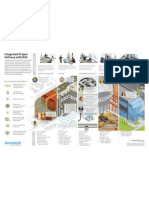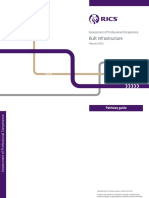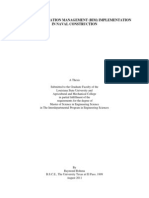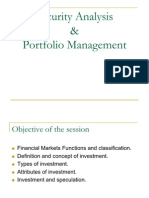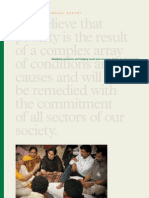Value Engineering (VE) in Design-Build: A Value Management Approach
Value Engineering (VE) in Design-Build: A Value Management Approach
Uploaded by
TAHER AMMARCopyright:
Available Formats
Value Engineering (VE) in Design-Build: A Value Management Approach
Value Engineering (VE) in Design-Build: A Value Management Approach
Uploaded by
TAHER AMMAROriginal Description:
Original Title
Copyright
Available Formats
Share this document
Did you find this document useful?
Is this content inappropriate?
Copyright:
Available Formats
Value Engineering (VE) in Design-Build: A Value Management Approach
Value Engineering (VE) in Design-Build: A Value Management Approach
Uploaded by
TAHER AMMARCopyright:
Available Formats
VA LU E E N G I N E E R I N G ( V E ) I N D E S I G N - B U I L D : A VA LU E M A N AG E M E N T A P P R O AC H
#5 01
Value Engineering (VE) in
Design-Build: A Value
Management Approach
M an u a l o f P ractice
The Number One Reference
Document for Professionals &
Students Researching the Basic
concepts and Key Elements of
the Design-Build Industry.
An Official DBIA
Manual of Practice Chapter
VA LU E E N G I N E E R I N G ( V E ) I N D E S I G N - B U I L D : A VA LU E M A N AG E M E N T A P P R O AC H
Table of Contents
1 | Introduction/Overview................................................................3
2 | Key Issues/Considerations...........................................................4
3 | Best Practices..............................................................................8
4 | Expectations..............................................................................13
5 | Summary..................................................................................15
VA LU E E N G I N E E R I N G ( V E ) I N D E S I G N - B U I L D : A VA LU E M A N AG E M E N T A P P R O AC H
1.0 Introduction
he following discussion provides general guidelines for including Value Engineering (VE) within design-build
project delivery. Application of the VE process in this context will include the design-builder. The sections
herein define VE and describe its process, merits, and benefits in the context of design-build. The options and
opportunities for VE implementation take into account diverse owner goals and the differing procurement laws
that define procurement possibilities. The formal VE studies addressed in this guide are the structured implementation of focused
VE events by trained facilitators during the course of a design-build project. All participants in a design-build project should
incorporate the underlying VE concepts and tenets throughout the planning and execution of the project.
The Value Methodology
Value Methodology (VM) is an organized system of investigation using
trained multi-disciplined teams to analyze the requirements of a project
for the purpose of achieving its essential functions at the lowest total cost
(capital, operation, and maintenance) over the life of the project.
Improved Value
Virtually all projects have opportunities for improved value, and the VE process has the objective of identifying those
opportunities. Value is proportional to the ratio of function over cost, where a projects function is defined as what it is expected
to do.
Value = Function/Cost
Alternatively, the term performance can be used instead of the term function.
Value is achieved by improving function and maintaining cost; by maintaining function while reducing cost; or by improving
function while reducing cost. VE can be defined as an analysis of a projects functions directed at improving performance,
3
VA LU E E N G I N E E R I N G ( V E ) I N D E S I G N - B U I L D : A VA LU E M A N AG E M E N T A P P R O AC H
reliability, quality, safety, and life-cycle cost.
Applicability of Value Engineering
Owners who derive benefit from a VE evaluation of their projects include both public (county, city, state, and federal,
including the military) and private sector entities. Project types can include any facility or structure type, such as
bridges, highways, buildings, hospitals, schools, court facilities, mass transit facilities, water treatment plants, and
marine facilities. VE is currently used by the U.S. Military and by many agencies at all levels of government, including
federal, state, and local.
Why Use VM/VE?
Capital Cost
Life-Cycle Cost
Design-Time
Decision Time
Quality
Value
Profitability
Ideas
2.0 Key Issues
Overview
The basic phases of a VE study include:
Information Phase:
Gather information about the project.
VA LU E E N G I N E E R I N G ( V E ) I N D E S I G N - B U I L D : A VA LU E M A N AG E M E N T A P P R O AC H
Function Analysis Phase:
Identify basic project functions and goals.
Creative Phase:
Formulate project alternatives.
Analysis Phase:
Evaluate project alternatives.
Evaluation Phase:
Develop best alternatives.
Presentation Phase:
Present recommendations.
Implementation Phase:
Incorporate suggestions into the project.
Study Features
VE studies identify project issues and provide opportunities to optimize the design in progress while validating project
scope, budget, and costs. Activities undertaken during VE studies include:
Understanding project criteria.
Identifying appropriate project scope.
Validating project initial cost and budget.
Ascertaining best value alternatives.
Evaluating life cycle costs.
Identifying and evaluating risk.
Assessing the schedule.
Reviewing constructability.
Evaluating contract/procurement options.
5
VA LU E E N G I N E E R I N G ( V E ) I N D E S I G N - B U I L D : A VA LU E M A N AG E M E N T A P P R O AC H
Minimizing change orders during construction.
Cost reduction as a standalone issue is not part of the VE process. Reduction
in cost is often an outcome of the process, although it is never achieved by
sacrificing functions essential to project success.
Team Formation
Formal VE studies should be lead by a trained facilitator (e.g., Certified Value Specialist - CVS). Studies are most successful when
qualified individuals from a range of disciplines and backgrounds are included in the team to achieve an optimum combination
of perspectives, owner requirements, project goals and constraints, and independent technical input.
Collaboration between owner and independent team members will encourage diversity and independence of thought. An
advantage of the integrated team is that the potential for organizational constraints can be overcome. Teams totally or mostly
composed of owner representatives are generally more constrained by policy, politics, guidelines, standard practice, and
regulations.
Implementation of Value Engineering
Paretos Law of Distribution
Total Cost (percentage)
100
80
60
VE in DB
Focus on major cost items
40
20
0
20
40
60
80
Number of Components (percentage)
6
100
VA LU E E N G I N E E R I N G ( V E ) I N D E S I G N - B U I L D : A VA LU E M A N AG E M E N T A P P R O AC H
Design-Bid-Build
The VE process does not change based on the project delivery method. In the standard design-bid-build scenario, the
VE study (or studies) can be performed at any time during the project delivery process, starting with scoping/planning
and continuing through various stages of design completion. Paretos Law of Distribution presented by the graph on the
previous page shows that a limited number of project elements correlate to a majority of project cost. The VE study will
generally focus on major project components as it determines best value.
VE at Planning/Scoping. Define project budget and parameters.
VE at 0% Design. Identify project requirements and issues.
VE at 15 % Design (Schematic). Validate and refine project concept and cost.
VE at 30% Design. Evaluate major systems and refine cost.
VE at 60% Design. Refine systems, cost, and constructability.
As the design and project schedule advance, each successive study performed offers a slightly different focus. Typically,
VE Savings Potential
When to use VE...
Scope/Concept
Development
Design
Construction
Time
7
Operations &
Maintenance
VA LU E E N G I N E E R I N G ( V E ) I N D E S I G N - B U I L D : A VA LU E M A N AG E M E N T A P P R O AC H
the earlier the study occurs, the greater the potential benefit. Owners may elect to contract for only one study or to have
multiple studies performed in response to project complexity or cost.
Design-Build
Design-build is a project delivery method in which design and construction are provided from a single source. Since
VE optimizes design and promotes project value, construction through the design-build project delivery method is
compatible with the goals of VE. Furthermore, VE will augment the benefits of design-build, since its focus extends
beyond cost-cutting and creativity in construction.
3.0 Best Practices
Implementing Value Engineering in Design-Build
There are numerous options and opportunities for implementing VE during the evolution of any project, and there
is no single best methodology for all owners. Owners should evaluate all implementation options to find the most
appropriate in terms of in-house manpower, expertise, available
time, budget, and legal procurement constraints. Owners are
Performing a VE study subsequent to designencouraged to implement VE and consider which type of VE
builder selection provides an opportunity
study to implement, when to implement it, and how many
technical experts to include on the VE team.
to include the contractor in the VE process
Performing a VE study subsequent to design-builder selection
provides an opportunity to include the contractor in the VE process one that can never happen during standard
design-bid-build. A VE study can be performed prior to the issuance of the RFP, similar to a standard procurement. An
additional VE study, subsequent to selection of the design-builder but prior to the Notice to Proceed, will benefit from
contractor participation.
Study Options
Option 1: During Planning/Scoping
Purpose:
Scope Validation
8
VA LU E E N G I N E E R I N G ( V E ) I N D E S I G N - B U I L D : A VA LU E M A N AG E M E N T A P P R O AC H
Funding:
Duration*:
Participants:
End Product:
Owner
1 Week (Max.)
O, F, E
Scope & Budget
Option 2: During Draft RFP
Purpose:
Review RFP/Refine Requirements
Funding:
Owner
Duration*:
1 Week (Max.)
Participants:
O, F, AE1
End Product:
RFP
Option 3: After Selection, Before NTP
Purpose:
Finalize Scope/Price
Funding:
Owner
Duration*:
1 Week (Max.)
Participants:
O, F, AE1, D-B (& AE2)
End Product:
Contract and Price
O = Owner
AE1=Owners Designer
AE2=Design-Builders Designer
F = Trained Facilitator
E = Experts
D-B = Design-Build Team
*Duration: 40-hour maximum workshop, excluding time for pre-study, site visits, or post-workshop report
preparation.
Study Descriptions
Option 1: During Planning/Scoping
9
VA LU E E N G I N E E R I N G ( V E ) I N D E S I G N - B U I L D : A VA LU E M A N AG E M E N T A P P R O AC H
Owners have their own methodologies for project need identification and budgeting. For certain high-profile, politically
sensitive, high-cost projects, it could prove beneficial to seek additional input to review issues including the schedule,
contract provisions, design and construction alternatives, and the budget.
Option 2: During Draft RFP
Performing VE studies prior to issuing RFPs to shortlisted design-build teams is similar to performing VE studies within
the standard design-bid-build procurement process. VE studies at this point review project design and RFP documents
including performance requirements for consistency and effectiveness. All accepted recommendations are included in
the RFP package. Costs for VE studies performed prior to the issuance of RFPs are borne by the owners.
Option 3: After Selection, Before NTP
VE Studies held after the selection of the design-build team but prior to issuing a Notice to Proceed include the owner,
AE1, the VE team (the trained facilitator and technical experts), and the design-builder, including AE2. The VE team
reviews the design-builders project approach, upon which they based their bid. The VE process also provides a forum
for the design-builder to question and/or provide alternatives to the stipulations contained in the RFP.
The timeframe for performing VE studies after selection but prior to proceeding is critical; the design-builder should not
be penalized with regard to the schedule. Recommendations stemming from a study at this point in the project should
only be implemented upon the concurrence of the owner and design-builder. Unilateral decisions by the owner should
be avoided so that the owner and design-builder maintain their respective share of risk, and the design-builder is not
forced to construct a project inconsistent with his experience or desired approach.
Improvement in project value can result from either a cost reduction or a cost increase if performance is enhanced. In
the event of a cost reduction, it is recommended that the owner and design-builder share such savings, similar to a
Value Engineering Change Proposal (VECP) submitted by a contractor during construction. Structure in the contract to
share all savings experienced during performance, including those resulting from VE cost reductions, is a design-build
best practice. Any changes during the VE process will not
affect the construction schedule, since they occur prior to
Structure in the contract to share all savings
the issuance of a Notice to Proceed. The design-builder is
experienced during performance...
thus motivated to participate in the VE process and will
is a design-build best practice.
not hold back for potential future considerations. The
percentage sharing of VE savings is determined by the
10
VA LU E E N G I N E E R I N G ( V E ) I N D E S I G N - B U I L D : A VA LU E M A N AG E M E N T A P P R O AC H
owner, although the split should be sufficient to engage the cooperation of the design-builder. Equal sharing of cost
savings is likely to serve as an incentive to the design-builder.
Should a recommendation or set of recommendations lead to a cost increase, the cost would be added to the designbuilders bid price, since the owner is deriving the full benefit from the change.
The cost for the VE study in Option 3 is borne by the owner. Funding for the study can be included as a fixed add cost
in the design-builders initial bid. As a variation, the owner may also require that the cost of the VE study be reimbursed
from implemented project cost savings and the additional savings then shared between the owner and design-builder.
Partnering
The process described above represents a true partnership between project participants, as both the owner and designbuilder have the same goals, although perhaps due to different motives.
Implementing VE in design-build subsequent to contractor (DB)
selection furthers partnership goals by:
Creating an effective project team
Developing project consensus
Establishing open lines of communication
Promoting group synergy
Risk
Compared to the design-bid-build scenario, in design-build project delivery the design-builder takes on significantly
more risk by committing to an early bid price. The construction price is developed from baseline design criteria and
project performance requirements prepared and established by the owner, combined with the design-build teams
own design development, which is significantly less than a 100% complete set of documents. Other protocols used
throughout the industry as the basis for the design-build bid include a standard design, or requesting a complete
performance design based upon given criteria. The risk assumed by the design-builder remains higher than in a designbid-build scenario.
11
VA LU E E N G I N E E R I N G ( V E ) I N D E S I G N - B U I L D : A VA LU E M A N AG E M E N T A P P R O AC H
A VE study performed prior to the release of the baseline RFP package will help manage the owners quantifiable risk
prior to involvement of the design-builder. The study will identify issues of concern and develop alternative solutions to
address those concerns.
Risk
e
Tim
Cost
Benefits
Quality
A VE study held in conjunction with the design-builder after its selection will help in managing risk for both the owner
and the design-builder. A study at this point will reduce the possibility of future claims by the design-builder, since
there is an opportunity to clarify project issues and modify stipulations early on in the project. The design-builders
participation in the VE study will ensure a more even sharing of project risk with the owner.
Life-Cycle Cost Analysis
The life-cycle cost, or total project cost over the useable life of a facility, equates to the initial capital cost plus future
operation and maintenance costs. The owner should not underestimate future cost during project scoping and design;
VE can be a useful tool in specifically addressing and estimating total project cost.
Projects that forego the VE process rely upon the designers estimate of total project cost. Life-cycle cost is usually
addressed by an owner requirement to design a facility for a specified useable life. Designers rarely perform a formal
life-cycle cost analysis, and instead use their experience and best judgment to estimate total cost. VE studies during the
early stages of design prior to issuance of the RFP will help identify structure types, materials, finishes, and equipment
12
VA LU E E N G I N E E R I N G ( V E ) I N D E S I G N - B U I L D : A VA LU E M A N AG E M E N T A P P R O AC H
or systems that require future cost to maintain function.
As long as the project requirements presented within the terms of the RFP are not violated (minimum condition met),
the design-builder is generally not concerned with life-cycle costs. VE within design-build procurement provides
another opportunity to address these issues. When the design-builder participates in a VE study with the owner and
designer, the issues associated with life-cycle cost and best value can be revisited to assure that the owners interest in
long-term viability and cost control are adequately addressed by the design solution.
4.0 Expectations
Study Deliverables
The typical VE study will provide the owner between 40 and 60 recommendations spanning various project categories
or disciplines, including:
Sample Categories of Recommendations:
Geotechnical/Foundation
Site/Utilities
Environmental/Permitting
Architectural
Structural
Electrical/Power
Mechanical/Plumbing/HVAC
Security
Specialty Equipment
Sample Issues Addressed:
Project Scope
Design Criteria
Design Standards
Alternative Construction
13
VA LU E E N G I N E E R I N G ( V E ) I N D E S I G N - B U I L D : A VA LU E M A N AG E M E N T A P P R O AC H
Risk Allocation
Schedule
Constructability
Quality
Value
Safety/Security
Life-Cycle Cost
Construction Cost
Many of the VE recommendations will have cost implications,
either adding or reducing cost in the quest for best value.
Some of the suggestions will be compatible with one
another, while some will be exclusionary, meaning that
not all recommendations can be implemented. The owner
and/or team participants will determine which of the
recommendations to carry forward and incorporate into the
project.
Cost Savings/Avoidance
Various agencies have documented cost savings from their VE programs, wherein construction cost reductions of well
over 5% on the baseline project cost estimate are common. The return on investment (ROI), or the cost of the VE study/
cost savings, is related to the construction cost of a project,
since the cost of the VE study is relatively stable. A ROI of
Many VE recommendations will have cost
over 100:1 is documented by some owners.
implications, either adding or reducing cost
Table II depicts a statistical sampling of the VE programs for
one federal agency, one state agency, and one city agency.
The agencies themselves furnished the information.
14
in the quest for best value
VA LU E E N G I N E E R I N G ( V E ) I N D E S I G N - B U I L D : A VA LU E M A N AG E M E N T A P P R O AC H
Table II. VE Study Statistics
AGENCY:
FHWA
CALTRANS
NYCOMB
01-04
03
00-04
1388
not applicable
61
Study Cost:
$32.4 M
$1.9 M
$1.4 M
Baseline Estimate:
$78.7 B
$2.6 B
$18.2 B
Cost Reduction:
$4.1 B
$0.2B
$1.1 B
% Cost Reduction*:
5.2%
7.8%
6.2%
Return on Investment
127:1
105:1
109:1
Years:
No. of Studies:
FHWA = Federal Highway Administration ; Caltrans = California Department of Transportation: NYCOMB =
New York City Office of Management and Budget
* The dollar amounts shown are the sum of cost reductions and cost increases from accepted recommendations.
Implementation of study recommendations historically tend to reduce project cost, but may also add cost if the
proposed benefits (value added) outweigh added expenditure.
5.0 Summary
The VE process is pertinent to the evaluation of any project type by any owner (public or private) and the earlier a VE
study is performed, the greater the potential benefits. It has positive impact on a project when studies are performed
during design for a standard design-bid-build scenario, and even more so for a design-build delivery as the designbuilder becomes integral to the process.
Benefits of Value Engineering in Design-Build
15
VA LU E E N G I N E E R I N G ( V E ) I N D E S I G N - B U I L D : A VA LU E M A N AG E M E N T A P P R O AC H
In conclusion, implementing VE within the design-build process provides the following benefits:
Generate cost shared savings for both the owner and the design-builder.
Spurs innovation in construction, since the terms of the owners RFP may be re-evaluated or
modified.
Minimize risk to both the owner and the design-builder due to the consensus approach to the
project.
Increase likelihood that the resulting project will satisfy owner and user needs.
DBIA thanks SAVE International for their contributions to this chapter. DBIA promotes the value of design-build project
delivery and teaches the effective integration of design and construction services to ensure success for owners and design
and construction practitioner.
SAVE International is the international society devoted to the advancement and promotion of the value methodology (also
called value engineering, value analysis or value management). Value methodology benefits include decreasing costs,
increasing profits and improving quality.
16
You might also like
- Karin's PPD & PDD Summary Sheets - V2.0No ratings yetKarin's PPD & PDD Summary Sheets - V2.018 pages
- AIA A201 2017 Comparative A101 Exhibit NewNo ratings yetAIA A201 2017 Comparative A101 Exhibit New43 pages
- CDT Handbook: For Certification CandidatesNo ratings yetCDT Handbook: For Certification Candidates15 pages
- Chapter 1 Productivity and Yield Section 1.1 Functional Productivity Example 1.1 Nokia CellphoneNo ratings yetChapter 1 Productivity and Yield Section 1.1 Functional Productivity Example 1.1 Nokia Cellphone4 pages
- Modern Methods of Construction Full PDFNo ratings yetModern Methods of Construction Full PDF81 pages
- Application of Bim To Improve Construction Safety Construction EssayNo ratings yetApplication of Bim To Improve Construction Safety Construction Essay8 pages
- Feasability Study of Application of BIM Data For Facility Management PDFNo ratings yetFeasability Study of Application of BIM Data For Facility Management PDF93 pages
- 1271 CIF Modern Methods of Construction Report v4No ratings yet1271 CIF Modern Methods of Construction Report v4156 pages
- Accredited Construction Details Quinn Building ProductsNo ratings yetAccredited Construction Details Quinn Building Products5 pages
- Integrated Project Delivery: A Working Defi NitionNo ratings yetIntegrated Project Delivery: A Working Defi Nition17 pages
- Aia, Bim Implamentation Guide, Aiab085571No ratings yetAia, Bim Implamentation Guide, Aiab08557148 pages
- 2002 AASHTO Roadside Design Guide: A Concise OverviewNo ratings yet2002 AASHTO Roadside Design Guide: A Concise Overview26 pages
- Amidds - Architectural - Building Congres PDFNo ratings yetAmidds - Architectural - Building Congres PDF413 pages
- Procedural Modelling Based BIM Approach For Railway DesignNo ratings yetProcedural Modelling Based BIM Approach For Railway Design17 pages
- Construction Documents - Services - Exam - GuideNo ratings yetConstruction Documents - Services - Exam - Guide19 pages
- Bibliography - Construction Management (4th Edition)No ratings yetBibliography - Construction Management (4th Edition)3 pages
- Signalized Intersections Informational GuideNo ratings yetSignalized Intersections Informational Guide15 pages
- The Owner's Dilemma - Driving Success and Innovation in The Design and Construction IndustryNo ratings yetThe Owner's Dilemma - Driving Success and Innovation in The Design and Construction Industry168 pages
- RICS APC Pathway Guide - Built Infrastructure-Feb 2015-WEBNo ratings yetRICS APC Pathway Guide - Built Infrastructure-Feb 2015-WEB32 pages
- The Future of Construction Final US LetterNo ratings yetThe Future of Construction Final US Letter36 pages
- Overview of Cross Laminated Timber CLT and Timber Structure Standards Across The WorldNo ratings yetOverview of Cross Laminated Timber CLT and Timber Structure Standards Across The World13 pages
- Automated Design Modular Buildings GCGANNo ratings yetAutomated Design Modular Buildings GCGAN21 pages
- Data Integrity Guide - Download For Free: Guest BlogNo ratings yetData Integrity Guide - Download For Free: Guest Blog8 pages
- BIM Implementation in Naval ConstructionNo ratings yetBIM Implementation in Naval Construction90 pages
- Engineering design management The Ultimate Step-By-Step GuideFrom EverandEngineering design management The Ultimate Step-By-Step GuideNo ratings yet
- Making and Curing Concrete Test Specimens in The Field: Standard Practice ForNo ratings yetMaking and Curing Concrete Test Specimens in The Field: Standard Practice For5 pages
- Keystone Hardscapes Standard II Straight or Tri-PlaneNo ratings yetKeystone Hardscapes Standard II Straight or Tri-Plane8 pages
- Annuities Part 1 Answers q1-27 Mortgages and Personal Finance NsNo ratings yetAnnuities Part 1 Answers q1-27 Mortgages and Personal Finance Ns6 pages
- Bond Portfolio Management Using The Dynamic Nelson-Siegel ModelNo ratings yetBond Portfolio Management Using The Dynamic Nelson-Siegel Model36 pages
- Oyo Rooms Another Unicorn in The Making Harvard Case Study SolutionNo ratings yetOyo Rooms Another Unicorn in The Making Harvard Case Study Solution22 pages
- Islamic Financial Accounting Standards To Ijarah by Ahmed AlNo ratings yetIslamic Financial Accounting Standards To Ijarah by Ahmed Al23 pages
- Microsoft'S Financial Reporting Strategy Case Study: Individual AssignmentNo ratings yetMicrosoft'S Financial Reporting Strategy Case Study: Individual Assignment6 pages
- Automobile Indu Stry: " Hailed As The Industry of Industries " - Peter DruckerNo ratings yetAutomobile Indu Stry: " Hailed As The Industry of Industries " - Peter Drucker21 pages
- From Competitive Advantage To Corporate StrategyNo ratings yetFrom Competitive Advantage To Corporate Strategy4 pages
- FINAL Geothermal Handbook TR002-12 Reduced100% (2)FINAL Geothermal Handbook TR002-12 Reduced164 pages
- Chapter 1 Productivity and Yield Section 1.1 Functional Productivity Example 1.1 Nokia CellphoneChapter 1 Productivity and Yield Section 1.1 Functional Productivity Example 1.1 Nokia Cellphone
- Application of Bim To Improve Construction Safety Construction EssayApplication of Bim To Improve Construction Safety Construction Essay
- Feasability Study of Application of BIM Data For Facility Management PDFFeasability Study of Application of BIM Data For Facility Management PDF
- Accredited Construction Details Quinn Building ProductsAccredited Construction Details Quinn Building Products
- Integrated Project Delivery: A Working Defi NitionIntegrated Project Delivery: A Working Defi Nition
- 2002 AASHTO Roadside Design Guide: A Concise Overview2002 AASHTO Roadside Design Guide: A Concise Overview
- Procedural Modelling Based BIM Approach For Railway DesignProcedural Modelling Based BIM Approach For Railway Design
- Bibliography - Construction Management (4th Edition)Bibliography - Construction Management (4th Edition)
- The Owner's Dilemma - Driving Success and Innovation in The Design and Construction IndustryThe Owner's Dilemma - Driving Success and Innovation in The Design and Construction Industry
- RICS APC Pathway Guide - Built Infrastructure-Feb 2015-WEBRICS APC Pathway Guide - Built Infrastructure-Feb 2015-WEB
- Overview of Cross Laminated Timber CLT and Timber Structure Standards Across The WorldOverview of Cross Laminated Timber CLT and Timber Structure Standards Across The World
- Data Integrity Guide - Download For Free: Guest BlogData Integrity Guide - Download For Free: Guest Blog
- Exploring Autodesk Navisworks 2024, 11th EditionFrom EverandExploring Autodesk Navisworks 2024, 11th Edition
- Engineering design management The Ultimate Step-By-Step GuideFrom EverandEngineering design management The Ultimate Step-By-Step Guide
- CS E10:2014 - Guidelines on Design Loads for Skyrise GreeneryFrom EverandCS E10:2014 - Guidelines on Design Loads for Skyrise Greenery
- Making and Curing Concrete Test Specimens in The Field: Standard Practice ForMaking and Curing Concrete Test Specimens in The Field: Standard Practice For
- Keystone Hardscapes Standard II Straight or Tri-PlaneKeystone Hardscapes Standard II Straight or Tri-Plane
- Annuities Part 1 Answers q1-27 Mortgages and Personal Finance NsAnnuities Part 1 Answers q1-27 Mortgages and Personal Finance Ns
- Bond Portfolio Management Using The Dynamic Nelson-Siegel ModelBond Portfolio Management Using The Dynamic Nelson-Siegel Model
- Oyo Rooms Another Unicorn in The Making Harvard Case Study SolutionOyo Rooms Another Unicorn in The Making Harvard Case Study Solution
- Islamic Financial Accounting Standards To Ijarah by Ahmed AlIslamic Financial Accounting Standards To Ijarah by Ahmed Al
- Microsoft'S Financial Reporting Strategy Case Study: Individual AssignmentMicrosoft'S Financial Reporting Strategy Case Study: Individual Assignment
- Automobile Indu Stry: " Hailed As The Industry of Industries " - Peter DruckerAutomobile Indu Stry: " Hailed As The Industry of Industries " - Peter Drucker








